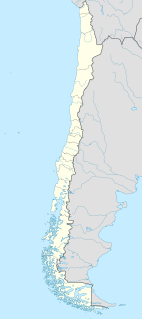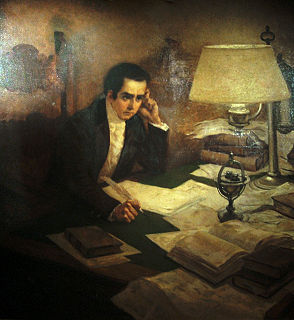
Santiago de Liniers, 1st Count of Buenos Aires, KOM, OM was a French officer in the Spanish military service, and a viceroy of the Spanish colonies of the Viceroyalty of the Río de la Plata. Although born "Jacques de Liniers" in France, he is more widely known by the Spanish form of his name, "Santiago de Liniers".

Trevelin is a town in the Patagonian Argentine province of Chubut. The town lies on the eastern banks of the Rio Percy/Río Percey. It is located in the department of Futaleufú, 22 kilometres south of Esquel, and had 6,395 inhabitants at the time of the 2001 census [INDEC] and 7,908 inhabitants in the 2010 census [INDEC].

José Manuel Emiliano Balmaceda Fernández was the 11th President of Chile from September 18, 1886 to August 29, 1891. Balmaceda was part of the Castilian-Basque aristocracy in Chile. While he was president, his political disagreements with the Chilean congress led to the 1891 Chilean Civil War, following which he shot and killed himself.

Felipe Pigna is an Argentine historian and writer. He is among the best selling book authors from Argentina.

María Aurelia Bisutti was an Argentine film and TV actress, with over 50 Argentine cinema and television credits between 1948 and 1993, as well as numerous roles in the theatre.

Balmaceda is a Chilean village located south east of Coyhaique in Aysén Region. Balmaceda has around 500 inhabitants, and has Aysén Region's largest airport and meteorological station, Balmaceda Airport. The first settlers arrived into the zone in early-20th century after being expelled from Argentina since the borders between Chile and Argentina were drawn in 1902. In 1917 Balmaceda was officially founded and was named after the Chilean president José Manuel Balmaceda. Balmaceda was initially one of the largest inland Chilean settlements in what is now the Aysén Region.
The Balmaceda family of Chile became politically influential during the 19th century, and played a very significant role in Chilean politics. The Balmaceda family is of Basque descent. They are members of the Castilian-Basque aristocracy in Chile.
Balmaceda Airport is an airport next to the village of Balmaceda, serving the Aysén Region of Chile. The airport is 4 kilometres (2.5 mi) west of the Argentina border, it is located 55 km south-east of Coyhaique, the regional capital.
The Battle of Tacuarí was a battle in Southern Paraguay between revolutionary forces under the command of General Manuel Belgrano, member of the Primera Junta government of Argentina, and Paraguayan troops under colonel Manuel Atanasio Cabañas, at the time at the service of the royalists.

Manuel Máximiliano Alberti was a priest from Buenos Aires, when the city was part of the Viceroyalty of the Río de la Plata. He had a curacy at Maldonado, Uruguay during the British invasions of the Río de la Plata, and returned to Buenos Aires in time to take part in the May Revolution of 1810. He was chosen as one of the seven members of the Primera Junta, considered the first national government of Argentina. He supported most of the proposals of Mariano Moreno and worked at the Gazeta de Buenos Ayres newspaper. The internal disputes of the Junta had a negative effect on his health, and he died of a heart attack in 1811.

Los mitos de la historia argentina is a series of books written by Felipe Pigna, focused on the History of Argentina. As of 2010 the series have four books, which span from the Spanish arrival to America up to the governments of Juan Domingo Perón.

Historia de Belgrano y de la Independencia Argentina is an Argentine history book written by Bartolomé Mitre. It is mainly a biography of Manuel Belgrano, but the author expanded the scope into the whole Argentine War of Independence, where Belgrano was involved. It was the first book about the history of Argentina, and as such it was the starting point of the historiography of Argentina. It includes as well the autobiography of Manuel Belgrano, which was published by the first time in this book.

Mariano Moreno en su mesa de trabajo is a portrait by the Chilean artist Pedro Subercaseaux. It shows the artist's interpretation of Mariano Moreno, Secretary of War of the Argentine Primera Junta, the first national government, working at his desk. It is currently regarded as the canonical image of Moreno.

The Gazeta de Buenos Ayres [sic] was a newspaper originating in Buenos Aires, United Provinces of the Río de la Plata, in 1810. It was initially used to give publicity to the government actions of the Primera Junta, the first post-colonial Argentine government. In the beginning it was written by Mariano Moreno, with the aid of the priest Manuel Alberti; Manuel Belgrano and Juan José Castelli were also part of its staff.

The Huarpes or Warpes are an indigenous people of Argentina, living in the Cuyo region. Some scholars assume that in the Huarpe language, this word means "sandy ground," but according to Arte y Vocabulario de la lengua general del Reino de Chile, written by Andrés Fabres in Lima in 1765, the word Cuyo comes from Araucanian cuyum puulli, meaning "sandy land" or "desert country".

The May Revolution was a week-long series of revolutionary events that took place from May 18 to May 25, 1810, in Buenos Aires. It started the Argentine War of Independence, and it is considered the birth of modern Argentina.

Luis Cobos is a Spanish composer, conductor and musician. He is chairman of the management entity performers (AIE) and the chairman of the board of the Latin Academy of Recording Arts & Sciences. He was married to the singer Angel.

Domingo Ortiz de Rozas (1721–1785) was a Spanish nobleman, who served in the Royal Guards at the service of the Spanish monarchs.

Señora Acero, also known as Señora Acero: La Coyote, is an American telenovela created by Roberto Stopello and it started airing on American broadcast channel Telemundo on 23 September 2014, and concluded on 29 January 2019. Produced by Argos Comunicación and Telemundo Studios, and distributed by Telemundo Internacional.

Agustina Ortiz de Rozas (1826-1898) was an Argentine philanthropist and political figure, president of the Sociedad de Beneficencia. She was the youngest sister of the general Juan Manuel de Rosas and was born in Buenos Aires. Ortiz married Lucio Norberto Mansilla at 15 years of age and had the following children with him: Lucio Victorio, Eduarda, Lucio Norberto, Agustina and Carlos. She was renowned as one of the most beautiful women of her time according to many of her contemporaries. She played some role in Argentina's founding.



















